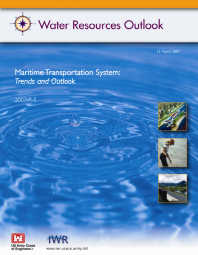
Maritime Transportation System: Trends and Outlooks

Executive Summary (excerpts)
Waterborne commerce is a key factor in the world and U.S. economies, and depends on a safe, efficient and reliable maritime transportation system. U.S. ports and waterways handle more than 2.5 billion tons of trade annually, most of the country’s international cargo and much of the total domestic production. The resulting benefits are ready access to a wide variety of products and services and lower costs for consumers.
The trends discussed in this paper are extensively interlinked. Changes in transportation activity and practice are driven by changes in the underlying demand occasioned by foreign and domestic trade, changes in logistics practices, changes in environmental constraints, changes in the political arena and changes in technology and resource costs. The team reviewed both government planning and policy documents and the applicable commercial literature to determine and describe cause-and-effect relationships. This report uses the most recent data available in consistent formats for tables and graphs. In most cases data are now available through 2005, but in some cases the comparable data series end in 2004. Forecasts, likewise, are on a consistent basis wherever possible, but are sometimes limited to the source data.
- Issues:
- Infrastructure, Climate Change, Economics, Natural Resources
- Regions:
- Global, North America
- Country:
- United States
- Year Published:
- 2007
- Institution:
- US Army Engineers Institute for Water Resources (IWR)

